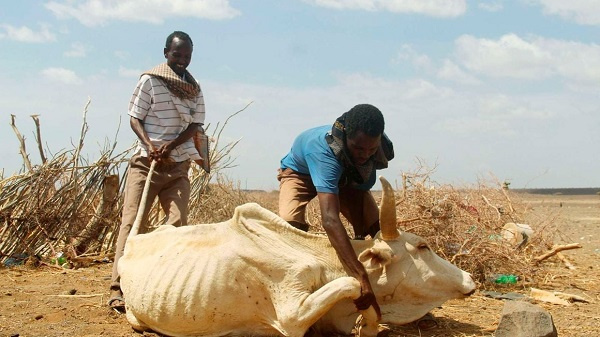
Herders assist an emaciated cow to stand in North Horr, Marsabit County in Kenya
NAIROBI, Nov 26 (NNN-GNA) — The Kenyan government has said it will need Ksh17 billion ($140 million) between now and January to respond to the worsening drought situation in the country, estimated to affect 4.3 million people.
On Friday, Deputy President Rigathi Gachagua launched the National Steering Committee on Drought Response, a special taskforce to drive a private-sector effort to mitigate the drought situation in the country in conjunction with the Kenya Red Cross. It will be composed of 15 members, mostly top executives from private and public firms and is led by Safaricom CEO Peter Ndegwa.
President William Ruto had on Tuesday said the committee’s formation was necessitated by the need to institutionalise the framework for mobilising additional resources to address the worsening drought impacts.
Needs in the arid and semi-arid lands (Asals) of Kenya continue to rise as the region faces its fifth consecutive below-average rainy season. The government and humanitarian partners stepped up collective response to save lives and alleviate the suffering caused by the unprecedented drought, saying they urgently needed more funding to avert the worst-case scenario in 2023.
The United Nations, which too on Monday made an international appeal for $472.6 million to tackle the drought going into next year, estimates that more than 4.35 million Kenyans are going to bed hungry and about 5 million people cannot access enough water. It added that more than 10 percent of the country’s population — or 6.4 million people — will need humanitarian assistance due to the drought next year, especially in the Asals.
It had been expected that the long-awaited rains would lessen the impact of the drought but this has not been the case.
Data from Kenya’s National Drought Management Authority point to dismal rainfall performance in the ongoing rainy season of October-November-December, and experts have warned that the number of those affected by drought could rise to six million by January 2023.
“Unfortunately, the short rains are projected to underperform, occasioning a possible fifth failed season that will phase into the seasonal dry spell in January to March 2023,” said DP Gachagua on Monday during a visit to Garissa County, noting that the government has spent over Ksh16 billion ($131 million) in its drought response efforts.
Gachagua, to whom the committee on private-sector-led National Drought Mitigation Appeal Fund, will report, said the additional Sh17 billion ($140 million) will support livelihood projects, food security interventions to strengthen the national capacity for resilient recovery in order to protect development gains from recurring droughts, such as rehabilitation of old water pans and dams as well as the sinking of new ones around the country.
“Our resources cannot be sufficient to address the challenges of climate change,” said Gachagua while launching the government of Kenya and the UN flash appeal for drought response in Garissa.
“We are in Garissa to bring a spotlight to the suffering being endured by Kenyans as a result of the global climate crisis. Our resources cannot be sufficient to address the challenges of climate change. Therefore, the government is appealing for assistance to address the resource gap in implementing drought interventions to minimise losses and catastrophic farming yields,” said Gachagua.
He said families are taking desperate measures to survive, including fleeing their homes in search of sustenance.
“Let us hold in our heads and hearts that each one of those 6.4 million who urgently need our help is an individual with hopes and dreams,” said UN Resident Coordinator in Kenya Stephen Jackson.
Data from the UN shows that 89 humanitarian partners reached nearly 1 million people with vital assistance between January and September, complementing the government-led response to the drought.
This includes 763,000 people who were assisted to access safe drinking water and received hygiene items. Aid agencies also reached 600,000 people with food assistance, including in-kind food, cash transfers or livelihood support
In addition, 293,000 children under the age of five and pregnant and lactating women received treatment for malnutrition. Multi-purpose cash was delivered to 176,000 people, enabling them to make dignified choices and purchase what they most needed. — NNN-GNA






